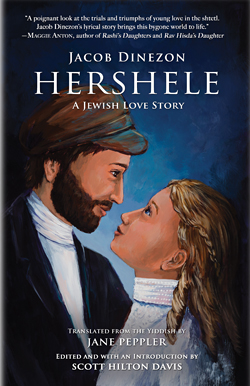
Association of Jewish Libraries Reviews
November/December 2016
Dinezon, Jacob. Hershele, A Jewish Love Story. Translated from the Yiddish by Jane Peppler. Raleigh, NC: Jewish Storyteller Press, 2016. 179 pp. $15.95. (9780979815676).
Jacob Dinezon wrote some of the first novels in Yiddish. Hershele was first published in 1891. Like many novels of the period in any language, it is filled with dramatic dialogue, sentimentality, and one-dimensional characters, with little attention to modern elements of fiction such as setting and mood. Nevertheless, it is a gripping tale, with a realistic adolescent love story, a complicated plot, and an unexpected ending. Even more important, it is packed with minutiae about life in a typical shtetl which contains a yeshiva whose students eat at different houses in town on different days of the week. The story goes into great detail about everyday customs, including foodways, economic practices, and the manipulations surrounding arrangements for marriages and the conflict for parents about whether to choose a learned man or a rich one. There is a wealth of information about the celebration of Purim and Passover, including a thorough description of the preparation for and performance of the Purim play, “The Selling of Joseph”. There is also lore pertaining to cantors of the period, including the “Vilner Balebasel”, and the lure of secular singing. Most significant for the hero, Hershele, is the “Vilner,” a fellow student who leads him to begin studying books of the Enlightenment. Hershele serves as much as an ethnographic resource as it does as a novel. This translation keeps the prose simple and the story moves quickly. Recommended for libraries that collect in Yiddish in translation, or stories about traditional Eastern European Jewry.
Beth Dwoskin, Proquest (Retired), Library Committee Chair, Beth Israel Congregation, Ann Arbor, MI
Foreword Reviews
August 26, 2016
Hershele, A Jewish Love Story. Reviewed by Claire Rudy Foster.
A romance that has stood the test of time, Jacob Dinezon’s touching, traditional novel was originally published in 1891. Recently translated from the Yiddish into contemporary English by Jane Peppler, Hershele: A Jewish Love Story remains a moving story of a poor student’s courtship of Mirele, a wealthy widow’s daughter. Described as “the Romeo and Juliet story of the shtetl,” Hershele is both a historical novel and a sweet, ageless romance.
“Hershele didn’t follow the path of the wicked and didn’t place himself in the way of sin,” but his righteousness confounds his pursuit of Mirele. What is proper? How can he woo her, when he has nothing to offer but himself? Hershele dwells on traditional themes and is deeply romantic. Observation of the Torah, refraining from physical contact with the opposite sex, and matchmaker-arranged marriages add to Hershele’s struggle—and his satisfaction when he celebrates small successes: “She came closer to see the words and pressed her burning cheek against his. He felt her body, her warmth, her heartbeats, and his heart pounded, too.” There’s more heat in Mirele’s proximity than a hundred ripped bodices. Hershele’s love is completely proper and yet, at the same time, intensified by its modesty.
Peppler’s translation is lively, capturing the spirit of Dinezon’s fable. Beautiful, lyrical sentences tease the imagination, painting a vivid picture of the two lovers: “When he looked in the mirror, he only saw Mirele: her cheeks shone like a pair of lovely roses, and in her eyes a radiant fire burned.”
Bit by bit, without compromising his faith, Hershele wins over his besherte, his soul mate. Their attraction, and the conflicts raised by their social disparity, is timeless.
